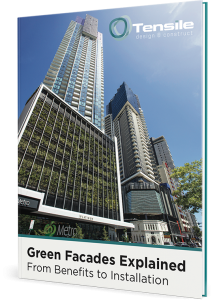Climate scientists have been telling us for some time that greenhouse gases are contributing to global warming. According to NASA, without action, we might see temperature increases of up to four degrees Celsius within a century.
Creating more green spaces in our towns and cities could go some way towards reducing the effects of global warming.
Going green to stay cooler
Green facades and walls are not just visually appealing, they can cool buildings down, as well as lower pollution and contribute to cleaner air.
Green structures can also help us cope with the urban heat island effect, a term that refers to the heat generated from cars, industry, people and built structures in our towns and cities.
In the absence of shading, the hard surfaces and thermal mass of buildings absorb heat from the sun and reflect it back into the atmosphere. This can make the local area hotter than less built-up areas.
Research shows that greenery and vegetation can contribute to localised cooling and help mitigate this effect. A recent study in London shows that living structures such as green facades and walls can reduce the surface temperature of a building by up to 12°C, and ambient temperatures by as much as 4°C.
CSIRO modelling has also demonstrated significant cooling in urban areas through use of vegetation and green spaces.
How it works
Green infrastructure contributes to cooling by shading hard surfaces that would usually absorb solar heat, and through plant irrigation and evaporation. In addition, leaving a gap between the plantings and the building wall creates flow-through breezes that enable passive cooling.
Green facades and walls can be retrofitted onto existing buildings or incorporated into new buildings at the design stage. They make a viable solution where it’s not easy or possible to incorporate ground-level garden spaces into existing built environments.
If you would like to know more about how green facades and walls can contribute to a cooler building, get in touch for a discussion.





































